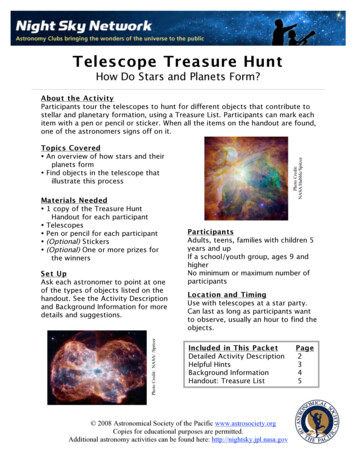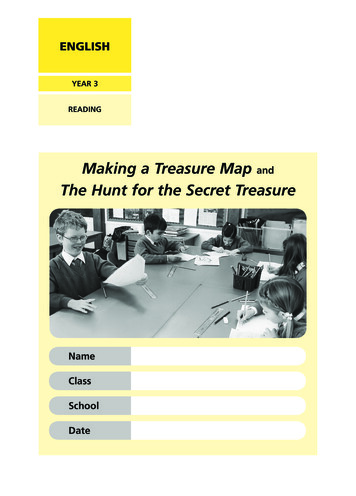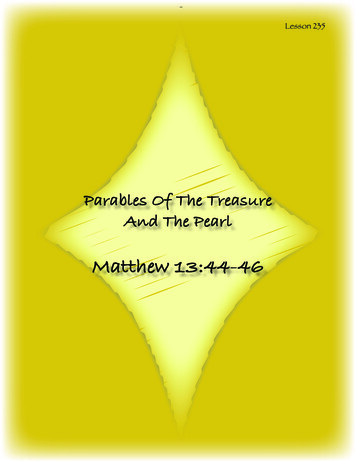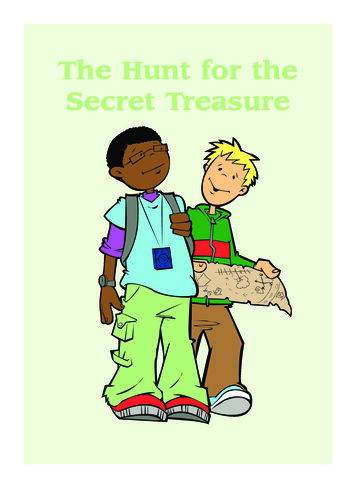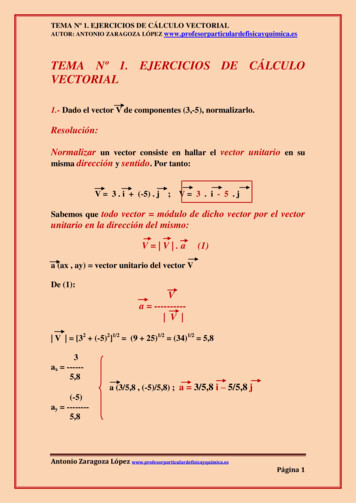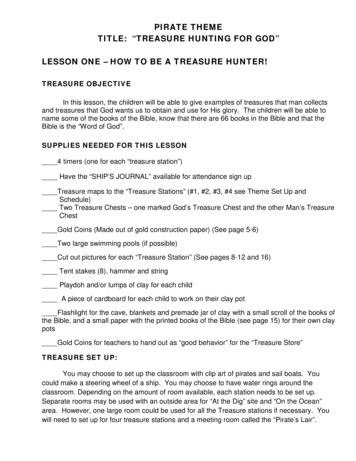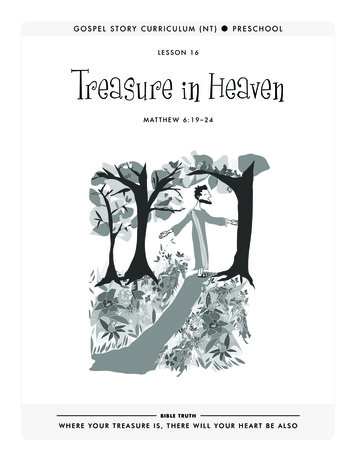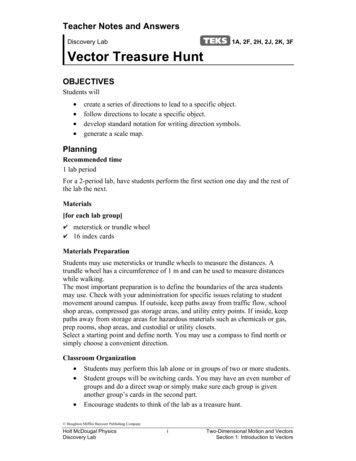
Transcription
Teacher Notes and AnswersDiscovery Lab1A, 2F, 2H, 2J, 2K, 3FVector Treasure HuntOBJECTIVESStudents will create a series of directions to lead to a specific object.follow directions to locate a specific object.develop standard notation for writing direction symbols.generate a scale map.PlanningRecommended time1 lab periodFor a 2-period lab, have students perform the first section one day and the rest ofthe lab the next.Materials[for each lab group]meterstick or trundle wheel16 index cardsMaterials PreparationStudents may use metersticks or trundle wheels to measure the distances. Atrundle wheel has a circumference of 1 m and can be used to measure distanceswhile walking.The most important preparation is to define the boundaries of the area studentsmay use. Check with your administration for specific issues relating to studentmovement around campus. If outside, keep paths away from traffic flow, schoolshop areas, compressed gas storage areas, and utility entry points. If inside, keeppaths away from storage areas for hazardous materials such as chemicals or gas,prep rooms, shop areas, and custodial or utility closets.Select a starting point and define north. You may use a compass to find north orsimply choose a convenient direction.Classroom Organization Students may perform this lab alone or in groups of two or more students.Student groups will be switching cards. You may have an even number ofgroups and do a direct swap or simply make sure each group is givenanother group’s cards in the second part.Encourage students to think of the lab as a treasure hunt. Houghton Mifflin Harcourt Publishing CompanyHolt McDougal PhysicsDiscovery LabiTwo-Dimensional Motion and VectorsSection 1: Introduction to Vectors
Teacher Notes and Answers continuedVector Treasure Hunt continued Safety warnings: The safety issues in this lab depend primarily on wherestudents will be working. Make sure students stay within the specifiedboundaries, and do not allow any disruptive behavior.CheckpointsStep 2: If students are counting paces as a measurement, encourage them to taketurns pacing out the distance. This will help remind them to convert paces tometers.Step 3: Some students will be tempted to use degrees to describe direction or tochoose directions between specified directions. Unless you wish to modify the labto include these options, this should be discouraged.Step 4: Encourage students to be creative in describing the path. Students willdevelop an understanding of vectors and two-dimensional motion by using a widerange of directions to describe straight-line motion.Step 6: Before handing a pack of cards to a group, shuffle them dramatically.Some students will realize that this is not a problem, but some will be convincedthat they will not be able to find the object if the directions are out of order.Step 7: Some students will add all the distances in each direction and find theobject by following the resultant. Others will simply begin following the cardsone at a time. Students may need help dealing with obstacles such as walls.Step 11: If possible, students should work on graph paper or a computer to makethe map. Houghton Mifflin Harcourt Publishing CompanyHolt McDougal PhysicsDiscovery LabiiTwo-Dimensional Motion and VectorsSection 1: Introduction to Vectors
Teacher Notes and Answers continuedVector Treasure Hunt continuedAnswers to:AnalysisA. Answers will vary, based on the object selected and the method used todescribe its location.B. Answers will vary, but most will be longer. Students may realize that thestraight-line path can be found by adding distances or by drawing a map andconnecting the points.C. Answers will vary.D. Answers will vary. Students should realize that using standard notation willallow others to find the object.E. Answers will vary. Some students may believe that the directions must befollowed in a specific order. Other students may realize that the order doesn’tmatter.F. Students should realize that it does not matter what order the directions aregiven in.G. Answers will vary. Students should realize that the cards identify the sameobject no matter what order they are in, so they could never be sure they werein original order.H. Answers will vary.I. Answers will vary. Some students may have noticed that they could simplyadd the distances in each direction.J. Answers will vary.K. Answers will vary. Differences should be explained by encountering obstaclessuch as walls or by following a more direct path than described by the cards.L. Students should realize that shuffling the cards had no effect on the positionsof the starting point and the object and that the path described between themwas probably not the same as the original description.M. Answers will vary. Students may realize that they could simply add thedistances in each direction and that this would work for any set of directions. Houghton Mifflin Harcourt Publishing CompanyHolt McDougal PhysicsDiscovery LabiiiTwo-Dimensional Motion and VectorsSection 1: Introduction to Vectors
Name Class DateDiscovery Lab1A, 2F, 2H, 2J, 2K, 3FVector Treasure HuntSAFETY Review the lab safety guidelines. Always follow correct procedures in the lab.OBJECTIVES Create a series of directions that lead to a specific object.Follow directions to locate a specific object.Develop a standard notation for writing direction symbols.Generate a scale map.MATERIALSmeterstick or trundle wheelindex cardsGiving directionsProcedure1. In this lab, you will select a large, fixed object at your school and use standardphysics notation to direct other students to the object. Your teacher will definethe starting point and the physical boundaries for this activity. Select an objectwithin the boundaries; the object you choose should be large and obvious, andit should be fixed in place so that other students will be able to find it byfollowing your directions.2. Plot out a course from the starting point to the chosen object. Remember towork quietly and to avoid disrupting classes and school traffic. Use ameterstick or trundle wheel to measure the distances along the course.Alternatively, you may measure your pace in meters and use your pace tocount out the distance for each part of the course. Convert your pace to metersbefore recording the values for each distance. Houghton Mifflin Harcourt Publishing CompanyHolt McDougal PhysicsDiscovery Lab1Two-Dimensional Motion and VectorsSection 1: Introduction to Vectors
Name Class DateVector Treasure Hunt continued3. You will break up the course into 15 different segments, and you will writeeach separate segment as a distance and a direction on an index card. Eachcard must contain a complete description of that segment, including themagnitude of the distance in meters and the direction. The direction must bespecified using only these terms: north, south, east, west, up, and down. Yourteacher will tell you where north is located for the purposes of this lab.4. Keep in mind that the cards may be used to describe the most direct path fromthe starting point to the object, broken up into 15 segments, or they maydescribe a complicated path with many changes of direction.5. When you have completed 15 cards that give an accurate description of a pathbetween the starting point and the chosen object, write your name on an indexcard, and place the card on top of the 15 cards. On a separate piece of paper, Houghton Mifflin Harcourt Publishing CompanyHolt McDougal PhysicsDiscovery Lab2Two-Dimensional Motion and VectorsSection 1: Introduction to Vectors
Name Class DateVector Treasure Hunt continuedwrite your name and a description of the object you chose, including adescription of its location. Give this paper and your deck of direction cards toyour teacher. Your teacher will keep the paper with the name of the objectuntil the end of the lab.AnalysisA. Do your cards describe the straight-line path to the object divided into 15parts, or do they describe a winding path to the object?B. Is the path described by your cards the same length or longer than thestraight-line path to the object? Can your cards be used to determine thestraight-line path? Explain.C. What was the most difficult part of plotting the path to the object?D. Are you confident that another group will be able to find the object usingyour direction cards? Explain why or why not.E. Would another group be able to find the object using your direction cardsif your cards were placed out of order? Explain your answer.Following directionsProcedure6. When you turn in your cards, your teacher will shuffle them well and give theshuffled cards to another lab group. You will receive a shuffled deck ofdirection cards made by another group.7. Devise a plan to use the directions on the cards you have been given to findthe object chosen by the other group, then attempt to find the object.8. When you find the object, go back through the cards to make sure you havecorrectly identified the object selected by the other group.9. When you are sure that you have found the correct object, report your resultsto your teacher. Your teacher will confirm whether you have correctlyidentified the object. If not, review the cards and try again.AnalysisF. Did shuffling the deck make it more difficult for you to locate the object?Explain why or why not.G. Would you be able to place the cards in their original order? Explain whyor why not.H. Did you find the object described by the other group’s cards? If not,explain what happened.I. Explain the method you used to find the object, and include any tricks youdiscovered while you were working.J. Was the other group able to correctly identify the object described by yourdirection cards? Houghton Mifflin Harcourt Publishing CompanyHolt McDougal PhysicsDiscovery Lab3Two-Dimensional Motion and VectorsSection 1: Introduction to Vectors
Name Class DateVector Treasure Hunt continuedMapping the courseProcedure10. In this section of the exercise, you will use the directions on a set of 15 cardsto draw a map of the path from the starting point to the object. You willgenerate a map of the complete set of directions you used to find the object.11. You will make the map by drawing each direction indicated on a card as anarrow. The arrow will be drawn to scale to represent the length in meters andit will point in the direction specified on the card. In a scale drawing such asthis, it is important for all the objects in the drawing to have the same sizerelationship as the actual objects. For example, the arrow representing 2.0 mwill be drawn twice as long as an arrow representing 1.0 m.12. Draw the first arrow so that its tail is at the starting point, the point of thearrow is pointing in the direction specified on the card, and the length of thearrow represents the distance on the card.13. Draw the second arrow on your map so that its tail starts at the point of thefirst arrow. The second arrow should also point in the direction specified bythe card, and its length should represent the distance on the card.14. Continue through the entire set of 15 cards. Draw the arrows tip-to-tail so thateach arrow begins where the preceding one ends.15. Make sure that the map is very neat. Include a legend, or key, that gives thedirections and defines the scale of the map. You may wish to indicate specificlandmarks, such as rooms or doors.AnalysisK. Does the map accurately reflect the path you took to find the object? Ifnot, explain any differences.L. Explain how shuffling the cards affected the way you represented thedirections from the starting point to the object. Use examples from yourmap to support your answer.M. Based on this exercise, describe the most efficient method of using the setof direction cards to locate the object. Would this work for any set ofdirections? Explain why or why not. Houghton Mifflin Harcourt Publishing CompanyHolt McDougal PhysicsDiscovery Lab4Two-Dimensional Motion and VectorsSection 1: Introduction to Vectors
Vector Treasure Hunt continued Answers to: Analysis A. Answers will vary, based on the object selected and the method used to describe its location. B. Answers will vary, but most will be longer. Students may realize that the straight-line path can be found by adding distances or by drawing a map and connecting the points. C. Answers will vary.
